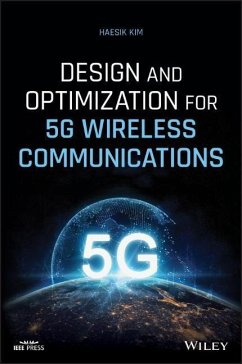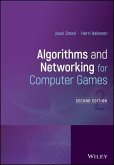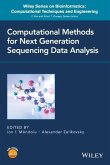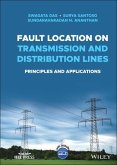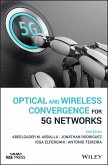Haesik Kim
Design and Optimization for 5g Wireless Communications
Schade – dieser Artikel ist leider ausverkauft. Sobald wir wissen, ob und wann der Artikel wieder verfügbar ist, informieren wir Sie an dieser Stelle.
Haesik Kim
Design and Optimization for 5g Wireless Communications
- Gebundenes Buch
- Merkliste
- Auf die Merkliste
- Bewerten Bewerten
- Teilen
- Produkt teilen
- Produkterinnerung
- Produkterinnerung
This book offers a technical background to the design and optimization of wireless communication systems, covering optimization algorithms for wireless and 5G communication systems design. The book introduces the design and optimization systems which target capacity, latency, and connection density; including Enhanced Mobile Broadband Communication (eMBB), Ultra-Reliable and Low Latency Communication (URLL), and Massive Machine Type Communication (mMTC).
The book is organized into two distinct parts: Part I, mathematical methods and optimization algorithms for wireless communications are…mehr
Andere Kunden interessierten sich auch für
![Wireless Blockchain Wireless Blockchain]() Wireless Blockchain127,99 €
Wireless Blockchain127,99 €![Algorithms and Networking for Computer Games Algorithms and Networking for Computer Games]() Jouni SmedAlgorithms and Networking for Computer Games90,99 €
Jouni SmedAlgorithms and Networking for Computer Games90,99 €![Computational Methods for Next Generation Sequencing Data Analysis Computational Methods for Next Generation Sequencing Data Analysis]() Ion MandoiuComputational Methods for Next Generation Sequencing Data Analysis119,99 €
Ion MandoiuComputational Methods for Next Generation Sequencing Data Analysis119,99 €![Fault Location on Transmission and Distribution Lines Fault Location on Transmission and Distribution Lines]() Swagata DasFault Location on Transmission and Distribution Lines127,99 €
Swagata DasFault Location on Transmission and Distribution Lines127,99 €![Foundations of Electromagnetic Compatibility Foundations of Electromagnetic Compatibility]() Bogdan AdamczykFoundations of Electromagnetic Compatibility133,99 €
Bogdan AdamczykFoundations of Electromagnetic Compatibility133,99 €![Optical and Wireless Convergence for 5g Networks Optical and Wireless Convergence for 5g Networks]() Optical and Wireless Convergence for 5g Networks137,99 €
Optical and Wireless Convergence for 5g Networks137,99 €![A Practical Introduction to Human-In-The-Loop Cyber-Physical Systems A Practical Introduction to Human-In-The-Loop Cyber-Physical Systems]() David NunesA Practical Introduction to Human-In-The-Loop Cyber-Physical Systems124,99 €
David NunesA Practical Introduction to Human-In-The-Loop Cyber-Physical Systems124,99 €-
-
-
This book offers a technical background to the design and optimization of wireless communication systems, covering optimization algorithms for wireless and 5G communication systems design. The book introduces the design and optimization systems which target capacity, latency, and connection density; including Enhanced Mobile Broadband Communication (eMBB), Ultra-Reliable and Low Latency Communication (URLL), and Massive Machine Type Communication (mMTC).
The book is organized into two distinct parts: Part I, mathematical methods and optimization algorithms for wireless communications are introduced, providing the reader with the required mathematical background. In Part II, 5G communication systems are designed and optimized using the mathematical methods and optimization algorithms.
The book is organized into two distinct parts: Part I, mathematical methods and optimization algorithms for wireless communications are introduced, providing the reader with the required mathematical background. In Part II, 5G communication systems are designed and optimized using the mathematical methods and optimization algorithms.
Produktdetails
- Produktdetails
- Wiley - IEEE
- Verlag: Wiley / Wiley & Sons
- Artikelnr. des Verlages: 1W119494550
- 1. Auflage
- Seitenzahl: 424
- Erscheinungstermin: 16. April 2020
- Englisch
- Abmessung: 244mm x 170mm x 28mm
- Gewicht: 880g
- ISBN-13: 9781119494553
- ISBN-10: 1119494559
- Artikelnr.: 58603292
- Herstellerkennzeichnung
- Libri GmbH
- Europaallee 1
- 36244 Bad Hersfeld
- gpsr@libri.de
- Wiley - IEEE
- Verlag: Wiley / Wiley & Sons
- Artikelnr. des Verlages: 1W119494550
- 1. Auflage
- Seitenzahl: 424
- Erscheinungstermin: 16. April 2020
- Englisch
- Abmessung: 244mm x 170mm x 28mm
- Gewicht: 880g
- ISBN-13: 9781119494553
- ISBN-10: 1119494559
- Artikelnr.: 58603292
- Herstellerkennzeichnung
- Libri GmbH
- Europaallee 1
- 36244 Bad Hersfeld
- gpsr@libri.de
DR. HAESIK KIM (IEEE Senior Member, Series Editor and Associate Technical Editor of IEEE Communications Magazine) is Senior Scientist of 5G and beyond network team in VTT Technical Research Centre of Finland. He is the recipient of the International Conference on Wireless Communications and Signal Processing (WCSP) Best Paper Award in 2010. His current research interests include PHY and MAC layer system design, advanced coding theory, advanced MIMO, multi-carrier system, interference mitigation techniques, resource allocation schemes, machine-type communications, ultra-reliable low latency communications, and machine learning.
Preface xi
List of Abbreviations xiii
Part I Mathematical Methods and Optimization Theories for Wireless Communications 1
1 Historical Sketch of Cellular Communications and Networks 3
1.1 Evolution of Cellular Communications and Networks 3
1.2 Evolution to 5G Networks 9
References 11
2 5G Wireless Communication System Parameters and Requirements 13
2.1 5G Requirements 13
2.2 Trade-off of 5G System Metrics 16
Problems 19
References 20
3 Mathematical Methods for Wireless Communications 21
3.1 Signal Spaces 21
3.2 Approximation and Estimation in Signal Spaces 32
3.2.1 Approximation Problems 32
3.2.2 Least Squares Estimation 35
3.2.3 Minimum Mean-Squared Error Estimation 45
3.2.4 Maximum Likelihood and Maximum A Posteriori Estimation 65
3.3 Matrix Factorization 71
3.3.1 LU Decomposition 71
3.3.2 Cholesky Decomposition 76
3.3.3 QR Decomposition 77
3.3.4 SVD Decomposition 85
Problems 92
References 95
4 Mathematical Optimization Techniques for Wireless Communications 97
4.1 Introduction 97
4.2 Mathematical Modeling and Optimization Process 99
4.3 Linear Programming 108
4.4 Convex Optimization 120
4.4.1 Barrier Method 124
4.4.2 Primal-Dual Interior Point Method 130
4.5 Gradient Descent Method 138
Problems 146
References 149
5 Machine Learning 151
5.1 Artificial Intelligence, Machine Learning, and Deep Learning 152
5.2 Supervised and Unsupervised Learning 153
5.3 Reinforcement Learning 177
Problems 191
References 193
Part II Design and Optimization for 5G Wireless Communications and Networks 195
6 Design Principles for 5G Communications and Networks 197
6.1 New Design Approaches and Key Challenges of 5G Communications and Networks 198
6.1.1 5G Frequency Bands 198
6.1.2 Low Latency 199
6.1.3 More Efficient Radio Resource Utilization 201
6.1.4 Small Cells and Ultra-Dense Networks 202
6.1.5 Higher Flexibility 202
6.1.6 Virtualization 203
6.1.7 Distributed Network Architecture 204
6.1.8 Device-Centric Communications 205
6.1.9 New Air Interfaces 206
6.1.10 Big Data Management 206
6.2 5G New Radio 207
6.2.1 5G Radio Access Network Architecture 207
6.2.2 5G NR Deployment Scenarios 208
6.2.3 Frame Structure 209
6.2.4 5G Logical, Transport, and Physical Channels 213
6.2.5 5G Protocol Layers 217
6.2.6 5G NR Physical Layer Processing 220
6.2.7 5G Initial Access Procedure and Beam Management 222
6.3 5G Key Enabling Techniques 226
6.3.1 5GWaveforms 226
6.3.2 5G Multiple Access Schemes 227
6.3.3 Channel Coding Schemes 228
6.3.4 MIMO 230
6.3.5 mmWAVE 231
6.3.6 Network Slicing 232
6.3.7 Multi-access Edge Computing 232
Problems 235
References 237
7 Enhanced Mobile Broadband Communication Systems 239
7.1 Introduction 239
7.2 Design Approaches of eMBB Systems 240
7.3 MIMO 242
7.3.1 Capacity of MIMO Channel 243
7.3.2 Space-Time Coding Design 251
7.3.3 Spatial Multiplexing Design 262
7.3.4 Massive MIMO 268
7.4 5G Multiple Access Techniques 271
7.4.1 OFDM System Design 271
7.4.2 FBMC, GFDM, and UFMC
List of Abbreviations xiii
Part I Mathematical Methods and Optimization Theories for Wireless Communications 1
1 Historical Sketch of Cellular Communications and Networks 3
1.1 Evolution of Cellular Communications and Networks 3
1.2 Evolution to 5G Networks 9
References 11
2 5G Wireless Communication System Parameters and Requirements 13
2.1 5G Requirements 13
2.2 Trade-off of 5G System Metrics 16
Problems 19
References 20
3 Mathematical Methods for Wireless Communications 21
3.1 Signal Spaces 21
3.2 Approximation and Estimation in Signal Spaces 32
3.2.1 Approximation Problems 32
3.2.2 Least Squares Estimation 35
3.2.3 Minimum Mean-Squared Error Estimation 45
3.2.4 Maximum Likelihood and Maximum A Posteriori Estimation 65
3.3 Matrix Factorization 71
3.3.1 LU Decomposition 71
3.3.2 Cholesky Decomposition 76
3.3.3 QR Decomposition 77
3.3.4 SVD Decomposition 85
Problems 92
References 95
4 Mathematical Optimization Techniques for Wireless Communications 97
4.1 Introduction 97
4.2 Mathematical Modeling and Optimization Process 99
4.3 Linear Programming 108
4.4 Convex Optimization 120
4.4.1 Barrier Method 124
4.4.2 Primal-Dual Interior Point Method 130
4.5 Gradient Descent Method 138
Problems 146
References 149
5 Machine Learning 151
5.1 Artificial Intelligence, Machine Learning, and Deep Learning 152
5.2 Supervised and Unsupervised Learning 153
5.3 Reinforcement Learning 177
Problems 191
References 193
Part II Design and Optimization for 5G Wireless Communications and Networks 195
6 Design Principles for 5G Communications and Networks 197
6.1 New Design Approaches and Key Challenges of 5G Communications and Networks 198
6.1.1 5G Frequency Bands 198
6.1.2 Low Latency 199
6.1.3 More Efficient Radio Resource Utilization 201
6.1.4 Small Cells and Ultra-Dense Networks 202
6.1.5 Higher Flexibility 202
6.1.6 Virtualization 203
6.1.7 Distributed Network Architecture 204
6.1.8 Device-Centric Communications 205
6.1.9 New Air Interfaces 206
6.1.10 Big Data Management 206
6.2 5G New Radio 207
6.2.1 5G Radio Access Network Architecture 207
6.2.2 5G NR Deployment Scenarios 208
6.2.3 Frame Structure 209
6.2.4 5G Logical, Transport, and Physical Channels 213
6.2.5 5G Protocol Layers 217
6.2.6 5G NR Physical Layer Processing 220
6.2.7 5G Initial Access Procedure and Beam Management 222
6.3 5G Key Enabling Techniques 226
6.3.1 5GWaveforms 226
6.3.2 5G Multiple Access Schemes 227
6.3.3 Channel Coding Schemes 228
6.3.4 MIMO 230
6.3.5 mmWAVE 231
6.3.6 Network Slicing 232
6.3.7 Multi-access Edge Computing 232
Problems 235
References 237
7 Enhanced Mobile Broadband Communication Systems 239
7.1 Introduction 239
7.2 Design Approaches of eMBB Systems 240
7.3 MIMO 242
7.3.1 Capacity of MIMO Channel 243
7.3.2 Space-Time Coding Design 251
7.3.3 Spatial Multiplexing Design 262
7.3.4 Massive MIMO 268
7.4 5G Multiple Access Techniques 271
7.4.1 OFDM System Design 271
7.4.2 FBMC, GFDM, and UFMC
Preface xi
List of Abbreviations xiii
Part I Mathematical Methods and Optimization Theories for Wireless Communications 1
1 Historical Sketch of Cellular Communications and Networks 3
1.1 Evolution of Cellular Communications and Networks 3
1.2 Evolution to 5G Networks 9
References 11
2 5G Wireless Communication System Parameters and Requirements 13
2.1 5G Requirements 13
2.2 Trade-off of 5G System Metrics 16
Problems 19
References 20
3 Mathematical Methods for Wireless Communications 21
3.1 Signal Spaces 21
3.2 Approximation and Estimation in Signal Spaces 32
3.2.1 Approximation Problems 32
3.2.2 Least Squares Estimation 35
3.2.3 Minimum Mean-Squared Error Estimation 45
3.2.4 Maximum Likelihood and Maximum A Posteriori Estimation 65
3.3 Matrix Factorization 71
3.3.1 LU Decomposition 71
3.3.2 Cholesky Decomposition 76
3.3.3 QR Decomposition 77
3.3.4 SVD Decomposition 85
Problems 92
References 95
4 Mathematical Optimization Techniques for Wireless Communications 97
4.1 Introduction 97
4.2 Mathematical Modeling and Optimization Process 99
4.3 Linear Programming 108
4.4 Convex Optimization 120
4.4.1 Barrier Method 124
4.4.2 Primal-Dual Interior Point Method 130
4.5 Gradient Descent Method 138
Problems 146
References 149
5 Machine Learning 151
5.1 Artificial Intelligence, Machine Learning, and Deep Learning 152
5.2 Supervised and Unsupervised Learning 153
5.3 Reinforcement Learning 177
Problems 191
References 193
Part II Design and Optimization for 5G Wireless Communications and Networks 195
6 Design Principles for 5G Communications and Networks 197
6.1 New Design Approaches and Key Challenges of 5G Communications and Networks 198
6.1.1 5G Frequency Bands 198
6.1.2 Low Latency 199
6.1.3 More Efficient Radio Resource Utilization 201
6.1.4 Small Cells and Ultra-Dense Networks 202
6.1.5 Higher Flexibility 202
6.1.6 Virtualization 203
6.1.7 Distributed Network Architecture 204
6.1.8 Device-Centric Communications 205
6.1.9 New Air Interfaces 206
6.1.10 Big Data Management 206
6.2 5G New Radio 207
6.2.1 5G Radio Access Network Architecture 207
6.2.2 5G NR Deployment Scenarios 208
6.2.3 Frame Structure 209
6.2.4 5G Logical, Transport, and Physical Channels 213
6.2.5 5G Protocol Layers 217
6.2.6 5G NR Physical Layer Processing 220
6.2.7 5G Initial Access Procedure and Beam Management 222
6.3 5G Key Enabling Techniques 226
6.3.1 5GWaveforms 226
6.3.2 5G Multiple Access Schemes 227
6.3.3 Channel Coding Schemes 228
6.3.4 MIMO 230
6.3.5 mmWAVE 231
6.3.6 Network Slicing 232
6.3.7 Multi-access Edge Computing 232
Problems 235
References 237
7 Enhanced Mobile Broadband Communication Systems 239
7.1 Introduction 239
7.2 Design Approaches of eMBB Systems 240
7.3 MIMO 242
7.3.1 Capacity of MIMO Channel 243
7.3.2 Space-Time Coding Design 251
7.3.3 Spatial Multiplexing Design 262
7.3.4 Massive MIMO 268
7.4 5G Multiple Access Techniques 271
7.4.1 OFDM System Design 271
7.4.2 FBMC, GFDM, and UFMC
List of Abbreviations xiii
Part I Mathematical Methods and Optimization Theories for Wireless Communications 1
1 Historical Sketch of Cellular Communications and Networks 3
1.1 Evolution of Cellular Communications and Networks 3
1.2 Evolution to 5G Networks 9
References 11
2 5G Wireless Communication System Parameters and Requirements 13
2.1 5G Requirements 13
2.2 Trade-off of 5G System Metrics 16
Problems 19
References 20
3 Mathematical Methods for Wireless Communications 21
3.1 Signal Spaces 21
3.2 Approximation and Estimation in Signal Spaces 32
3.2.1 Approximation Problems 32
3.2.2 Least Squares Estimation 35
3.2.3 Minimum Mean-Squared Error Estimation 45
3.2.4 Maximum Likelihood and Maximum A Posteriori Estimation 65
3.3 Matrix Factorization 71
3.3.1 LU Decomposition 71
3.3.2 Cholesky Decomposition 76
3.3.3 QR Decomposition 77
3.3.4 SVD Decomposition 85
Problems 92
References 95
4 Mathematical Optimization Techniques for Wireless Communications 97
4.1 Introduction 97
4.2 Mathematical Modeling and Optimization Process 99
4.3 Linear Programming 108
4.4 Convex Optimization 120
4.4.1 Barrier Method 124
4.4.2 Primal-Dual Interior Point Method 130
4.5 Gradient Descent Method 138
Problems 146
References 149
5 Machine Learning 151
5.1 Artificial Intelligence, Machine Learning, and Deep Learning 152
5.2 Supervised and Unsupervised Learning 153
5.3 Reinforcement Learning 177
Problems 191
References 193
Part II Design and Optimization for 5G Wireless Communications and Networks 195
6 Design Principles for 5G Communications and Networks 197
6.1 New Design Approaches and Key Challenges of 5G Communications and Networks 198
6.1.1 5G Frequency Bands 198
6.1.2 Low Latency 199
6.1.3 More Efficient Radio Resource Utilization 201
6.1.4 Small Cells and Ultra-Dense Networks 202
6.1.5 Higher Flexibility 202
6.1.6 Virtualization 203
6.1.7 Distributed Network Architecture 204
6.1.8 Device-Centric Communications 205
6.1.9 New Air Interfaces 206
6.1.10 Big Data Management 206
6.2 5G New Radio 207
6.2.1 5G Radio Access Network Architecture 207
6.2.2 5G NR Deployment Scenarios 208
6.2.3 Frame Structure 209
6.2.4 5G Logical, Transport, and Physical Channels 213
6.2.5 5G Protocol Layers 217
6.2.6 5G NR Physical Layer Processing 220
6.2.7 5G Initial Access Procedure and Beam Management 222
6.3 5G Key Enabling Techniques 226
6.3.1 5GWaveforms 226
6.3.2 5G Multiple Access Schemes 227
6.3.3 Channel Coding Schemes 228
6.3.4 MIMO 230
6.3.5 mmWAVE 231
6.3.6 Network Slicing 232
6.3.7 Multi-access Edge Computing 232
Problems 235
References 237
7 Enhanced Mobile Broadband Communication Systems 239
7.1 Introduction 239
7.2 Design Approaches of eMBB Systems 240
7.3 MIMO 242
7.3.1 Capacity of MIMO Channel 243
7.3.2 Space-Time Coding Design 251
7.3.3 Spatial Multiplexing Design 262
7.3.4 Massive MIMO 268
7.4 5G Multiple Access Techniques 271
7.4.1 OFDM System Design 271
7.4.2 FBMC, GFDM, and UFMC

